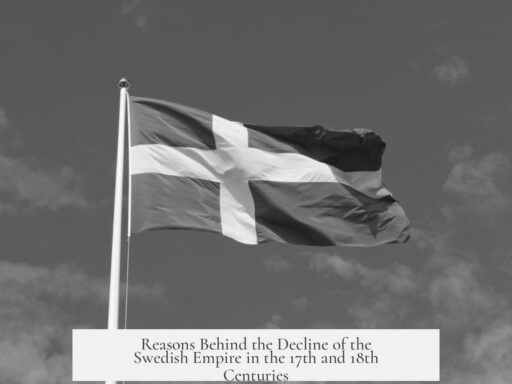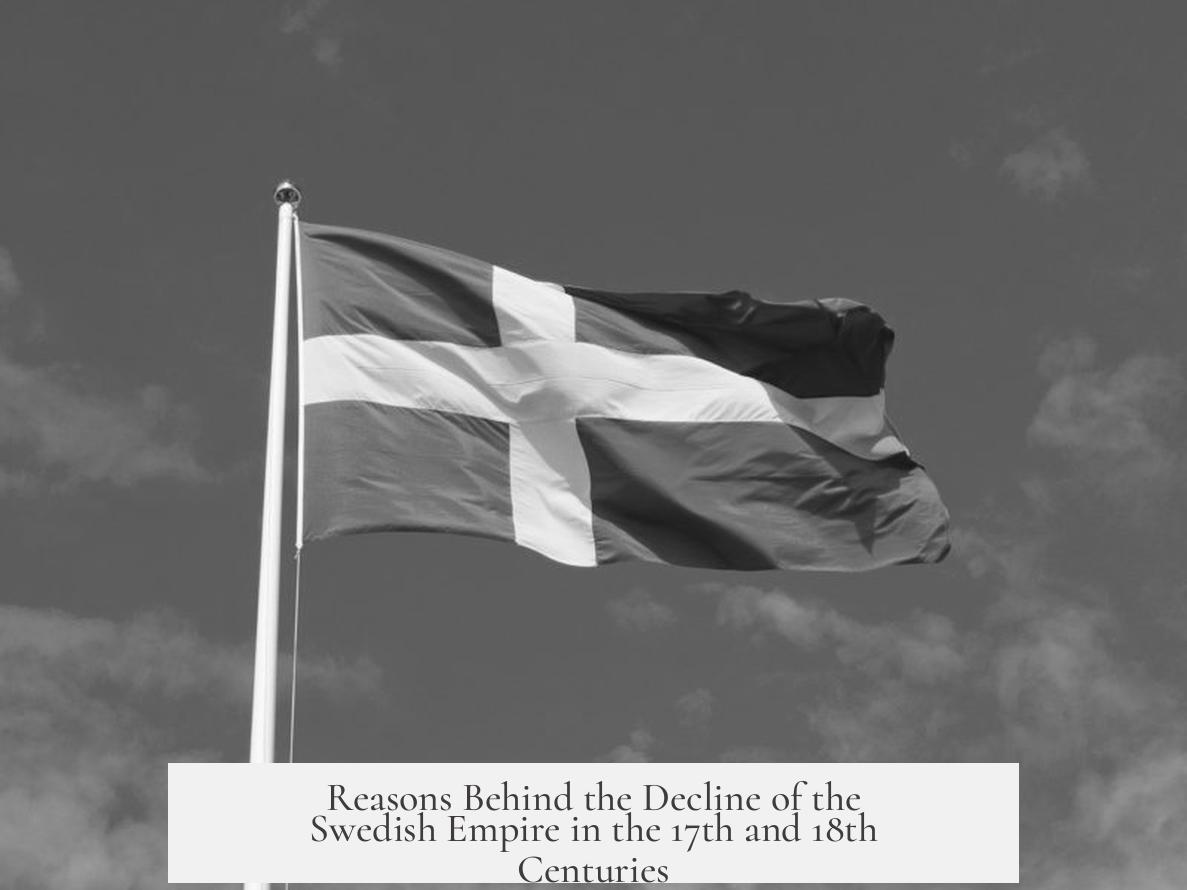The main reasons for the fall of the Swedish Empire in the 17th and 18th centuries center on the Great Northern War, overwhelming military pressures, a devastating plague, and limits to sustained military strength.

The Great Northern War (1700-1721) is the principal event driving Sweden’s decline. The empire faced a coalition of powers including Denmark-Norway, Russia, Poland-Lithuania, Saxony, Hannover, Lübeck, and Brandenburg-Prussia. This broad alliance overwhelmed Sweden. As a result, Sweden lost key territories such as Ingria, Kexholm, Bremen, Estonia, and Livonia. These losses marked the end of Sweden’s status as a grand power.
Sweden’s military struggled with multiple enemies on several fronts simultaneously. Battles often saw Swedish forces outnumbered at least 1.25 to 1, and usually by even larger margins. This stretched Sweden’s military capabilities beyond sustainable limits. Despite initial victories, prolonged strain reduced their fighting capacity.

- Sweden fought Denmark-Norway, Russia, Poland-Lithuania, and others.
- Faced numerical disadvantages in every major battle.
- Maintained military pressure for over two decades.
A crippling plague epidemic in 1710 further weakened Sweden’s ability to field soldiers. The population loss hindered recruitment and replenishment of the army during an already challenging war. This demographic crisis exacerbated military difficulties and reduced resilience.
Sweden had a strong military tradition and effective leadership. King Karl XI built a semi-professional army that won key battles early under his son Karl XII. Victories at Narva (1700), Düna (1701), and Fraustadt (1706) showcased Sweden’s tactical skill. However, Sweden had to rebuild the army multiple times during the war (in 1700, 1710, and 1715), indicating unsustainable losses.

| Factor | Impact |
|---|---|
| Great Northern War | Loss of territory and great power status |
| Multiple Enemies | Overextended military resources |
| Plague Epidemic | Demographic collapse and manpower shortage |
| Military Strength | Early victories but eventual exhaustion |
Overall, the Swedish Empire’s decline results from combined military defeat, demographic crisis, and prolonged conflict. Its legacy includes notable battlefield success but ultimately an inability to maintain dominance. The loss of key Baltic territories ended its era as a major European power by 1721.
- Great Northern War was decisive in Sweden’s decline.
- Multiple enemies and fronts drained resources.
- Plague drastically reduced army replenishment.
- Strong military leadership delayed but did not prevent fall.
What Are the Main Reasons for the Fall/Decline of the Swedish Empire in the 17th/18th Century?

The Swedish Empire’s decline in the 17th and 18th centuries is mainly due to the Great Northern War, overwhelming multi-front conflicts, a devastating plague epidemic, and the natural limits of sustaining a military force despite battlefield brilliance. But there’s a fascinating story behind each factor that brings this historic fall to life.
Let’s dive deep into the reasons why Sweden, once a giant in European power politics, bowed out from its grand stage by 1721.

The Great Northern War: When Too Many Rivals Gang Up
Imagine being the star player in a game, only to suddenly face a team made up of all the other best players combined. This is basically the story of Sweden in the Great Northern War (1700-1721). Sweden went head-to-head against a coalition containing Denmark-Norway, Russia, Poland-Lithuania, Saxony, Hannover, Lübeck, and Brandenburg-Prussia.

That’s right—seven enemies at once. No wonder Sweden’s shoulders buckled under such pressure. The empire shattered, losing huge territories: Ingria, Kexholm, Bremen, Estonia, and Livonia. The dream of grand power status faded, with the Treaty of Nystad in 1721 sealing Sweden’s fall from grace.
So, the key takeaway? If your “to-defeat” list is longer than your army is big, it’s game over.

Overextended Military Commitments and Facing More Than Your Match
Sweden’s military faced constant challenges. Battles consistently pitted them against numerical odds of at least 1-to-1.25, often worse. It’s like walking into a boxing ring with six opponents at once. How long do you think you’d last?
Despite having a disciplined and semi-professional army, Sweden’s forces stretched too thin. Fighting on so many fronts drained resources, forcing leaders to make impossible choices about where to defend or attack next. It’s a classic case of “biting off more than you can chew.”
The Hidden Enemy: The 1710 Plague Epidemic
Here’s a bitter plot twist: even the mightiest armies can falter against microscopic foes.
In 1710, Sweden faced a crippling plague epidemic. This outbreak tore through the population, devastating both civilians and the military. Suddenly, raising new armies wasn’t just difficult—it became nearly impossible.
This pandemic didn’t just slow Sweden down; it mercilessly gutted their ability to keep fighting. The Historiska Museet exhibition famously noted how the plague, alongside military defeats, was a primary reason for Sweden’s decline. It’s a reminder that war isn’t always lost on the battlefield; sometimes it’s lost in the sickrooms.
The Irony of Military Strength and Leadership
What’s striking is that Sweden’s decline wasn’t because they lacked military skill or leadership. Under King Karl XI, a “fantastic semi-professional army” was built, which Karl XII expertly led to many spectacular victories. Battles like Narva (1700), Düna (1701), Kliszow (1702), and others are remembered as masterful military feats.
Yet, despite these tactical wins, the empire simply couldn’t sustain the effort.
Sweden had to raise that army three times—in 1700, 1710, and 1715—each time draining precious human resources. Repeated mobilizations amidst plague and warfare stretched the population’s limits. It’s like having an excellent orchestra but losing too many musicians to keep playing major symphonies.
Putting It All Together: Why Did the Swedish Empire Fall?
The fall wasn’t due to a single blunder. It was a powerful cocktail of challenges: Sweden facing too many enemies simultaneously, fighting an exhausting war, suffering devastating population losses from plague, and exhausting its military reserves despite brilliant generals.
It’s easy to admire Sweden’s early 18th-century military victories. But one must also appreciate the harsh reality: no empire, no matter the victories, can survive endless war without enough people and resources to back it up.
The Swedish Empire’s story teaches us that empires die not always from external force alone but also from the compounded strain of multiple crises. Are there any modern parallels? Could current powers stretched thin on many fronts learn from Sweden’s fate?
Lessons for Today: Practical Reflections
- Don’t engage too many battles at once. Stretching forces too thin risks collapse, no matter how skilled or brave you are.
- Maintain solid domestic health and resource reserves. Sweden’s plague epidemic was a silent killer that chipped away at its strength.
- Leadership can win battles, but logistics win wars. Karl XI and Karl XII were strategic geniuses, but even they couldn’t counterbalance demographic and resource weaknesses.
Studying the fortune-flipping fall of the Swedish Empire reminds us how history weaves military brilliance with human vulnerability. It’s not just about winning battles but sustaining strength through adversity.
“The greatest empire is only as strong as its people and its ability to face challenges on multiple fronts.”
So next time you think of Sweden’s empire, remember the epic battles, but also remember the plague’s unforgiving toll, the overwhelming enemies, and the limits faced by even the mightiest armies.




